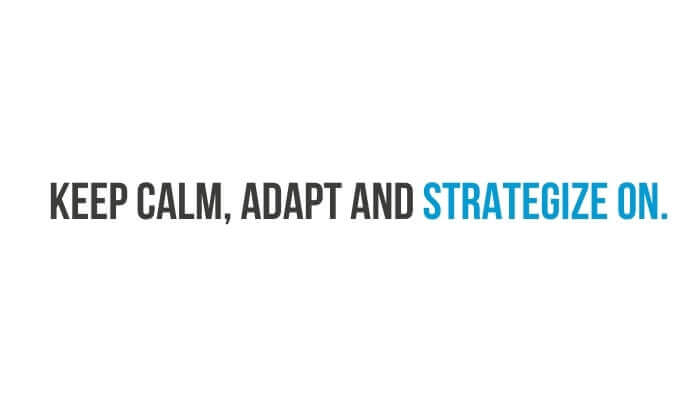How to adapt your marketing strategy during the coronavirus pandemic
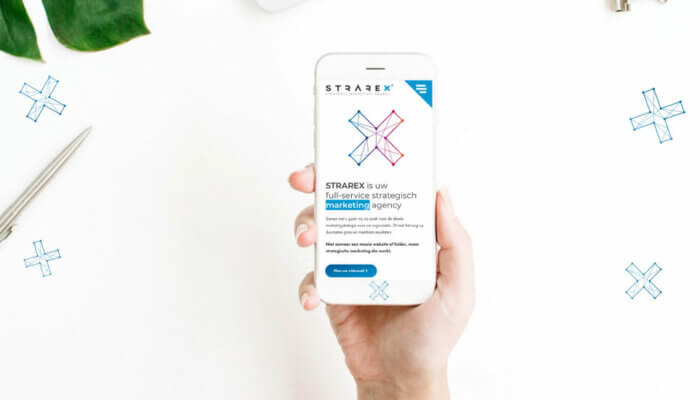
Here’s the situation: in a market where established incumbents and sectors are struggling and everyone [even those who never ever had a single website] suddenly goes online, many business owners, entrepreneurs and marketers have their hands in their hair…how’s it possible that some companies see their demand drop, while others can’t keep up with new peaks in sales?
Below, we look back at how we experienced the first wave since spring, and especially, the learnings during this pandemic – both for the human side of business and companies.
Coronavirus vs Entrepreneurs: The survival guide starts with the basics.

Surviving Covid-19 as a business…how do you start? Well, it sounds very cliché, but everything starts with a good basis: a good strategy for your company with clear goals, so you know exactly what you want to do and how you are going to achieve it. Suppose you want to build a company’s metaphorical skyscraper. Then you don’t just start buying bricks and lay them on top of each other until you have a building. Even if you are lucky enough to erect a building, it’s likely to topple over at the first gust of wind or have some serious construction issues.
And yet, this is what many companies did and are doing during the crisis. Or even crazier, they have a strategy and clear goals they are working towards, but when the first wave hit, they abandoned their strategy and started just doing (no, not Nike’s “just do it” kind of daring actions, but more like, the ones you shouldn’t just do impulsively). The panic monster took over and companies decided to “digitalize.” That’s how many webshops appeared out of nowhere. Nobody knew exactly why they were doing it, but when everyone else is doing it, it’s good, isn’t it? Then, when you take a look, some webshops are doing well, others are not. How’s that possible?
Let’s go back to the example of the skyscraper. Instead of starting to build around and do something yourself, it seems wiser to hire an architect who will look at what is possible with the location, make a clear plan, inspect all logistics necessary for safe building,, and eventually propose a contractor to execute his plans effectively. This is exactly the same when you run a (successful) business.
Ideally, you’ll be assisted by someone who will look with you at how you determine the best strategy for your company. Someone who does external research into what is possible in the market. Someone who analyses your marketing internally to see what can be done even better and translates this into a clear marketing plan with ambitious, but realistic goals. And she/he also has the right tools and knows how to implement these effectively with a tactical implementation.
It’s therefore logical that when a launch of a webshop is not implemented in the image of the company and with the appropriate strategy, after a few months it’ll dilute. Don’t get us wrong, we fully applaud digitalization and are aware that a digital presence and e-commerce are must-haves for any company. However, we also believe that if you choose to do this as a company, you need to approach it in a thoughtful way. Your digitalization should be an extension of your strategy and of your company.
What’s the effect of COVID-19 on consumer behavior?
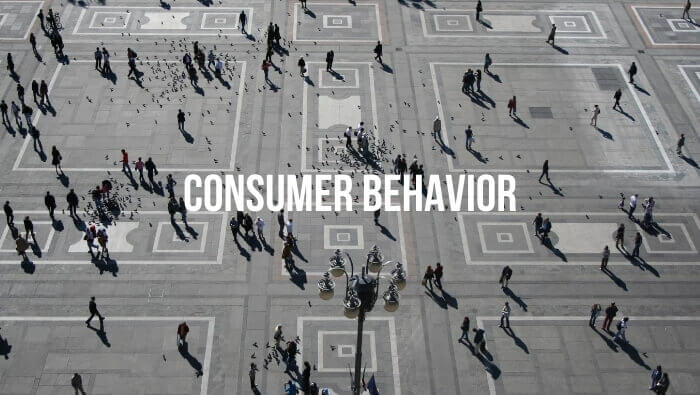
The big winner: Online sales
However, now that life is gradually returning to its “normal” course, we note that this will not be the same with COVID-19 around. To see how life might possibly evolve, we look at countries that have been affected by the virus before us. For example, in China, where life seems to be “normal” again, online sales have increased by 3%. We expect a similar trend in our country. This is because the people who didn’t shop online before, have now (although not by preference) discovered the convenience of this.
Hygiene and home-improvement
It makes sense that everyone creates a webshop in times when you can no longer physically go shopping. If you look at the figures of the last six months you see a changing pattern in consumer behavior.
Research agency Nielsen notes that:
- Consumers are less sensitive to the price of sought-after products (ones they really feel they need; for example, shavers // fitness mat // racing bike…).
- Same trend occurred for certain hygiene and protective products such as alcohol gel, N95 mouth masks and, somewhat surprisingly, toilet paper rose to unprecedented heights due to the strong increase in demand. This reached a point where both online and offline alternatives arose, and these products were sometimes sold at ridiculous prices.
- Moreover, [Luxury] products that make life at home more pleasant are doing very well. Bol.com saw their sales of board games, books, DIY (do-it-yourself) products, etc. increase.
Buying locally
As a last trend, we noticed an unexpected and almost unseen support from the Belgians for their local shops. From #Kooplokaal over #CaféSolidair to your baker in the street: the support of the people was heartwarming! It suddenly rained initiatives to help entrepreneurs, care providers and fellow Belgians. We hope, of course, that this renewed awareness will continue even after the corona crisis for the betterment of the entire economy.
What did we see before, during and after the first wave?
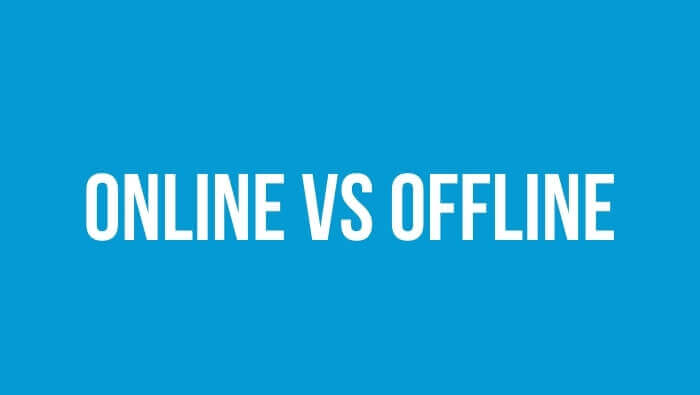
We have a healthy mix of online and offline customers, resulting in a bizarre situation where a number of (offline) customers had a hard time and in many cases quickly went online, and on the already digitalized side an online euphoria that could no longer follow the demand.
Online customers and spending peaked tremendously in the first few months of the pandemic, but are now experiencing volatile fluctuation and even a hard decline in some periods. During this fluctuation period, the smart players [ones who had a strategy and stuck to it] have taken the time to collect data and optimize platforms, resulting in significant gains. While others are falling back to the level they were before.
Below is a graph of one of our online e-commerce projects:

Let’s take a closer look at these charts.
Period A:
- Leading up to the first lockdown:
- Normal baseline regarding the number of orders.
- The e-commerce platform has a number of fundamental challenges that need to be addressed. Think of an abnormal high number of clicks, checkouts, … It’s difficult to maintain market share in the market. Social and Google ad spend at 100%
- We slagen er moeilijk in om het marktaandeel in de markt te handhaven.
- Social and Google ad spend at 100%
Period B:
- Start of the lockdown:
- Online campaigns pick up market demand.
- End users bite through the challenges of the platform because they really want and need the products to satisfy both desires and needs. There’s currently no offline alternative.
- Platforms manage to follow the sudden sharp increase in demand.
- Social and Google ad spend 100%
Period C:
- Second half of the lockdown:
- Highly targeted campaigns outperform market demand.
- Strong focus on social campaigns.
- Minimal platform optimizations (mainly a few updates on checkout section).
- Success in significantly outperforming the market.
- Social and Google ad spend at 250%
Period D:
- Panic and the nightmare for every marketer: At the request of the client (owners of the platform), the ongoing campaigns must be put on hold immediately since the logistics channel cannot follow. Both the production of products and logistics partners cannot cope with the increased need for capacity. All campaigns run from one day to the next (off and on). Not ok, our friends from Google (and their algorithm) really don’t like this. Optimizations to the platform remain as before, no further developments.
- Sales drop from one day to the next with -90%
- Social and Google ad spend at 0%
Period E:
- Fall back after quarantine:
- Sales drop further, but we do see an increase of 1200% compared to the period before COVID-19.
- Optimizations to the platform ensure higher conversion rates.
- Construction of customer database ensures repeat purchases.
- Sales fall back in line with market demand, on average 12x higher than pre-quarantine, but the market is no longer outperformed.
- Social and Google ad spend at 100%
Online is not as simple as one thought.

Maybe the holy grail of going online quickly isn’t as easy as many expected.. Every web agency and other larger players suddenly offered webshops at bargain prices or in some cases completely for free.
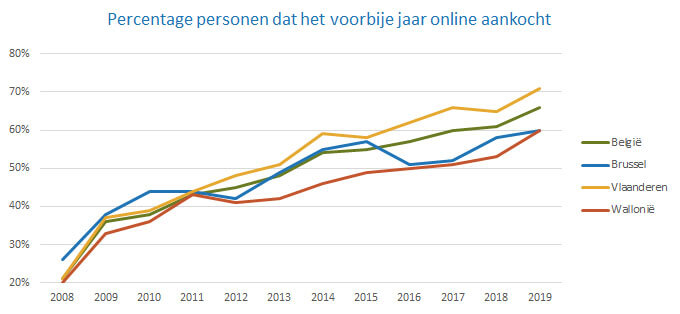
It was about time the digital transformation got a push. There’s been a significant increase in online sales for years and a switch to e-commerce/digital is inevitable. In Belgium we also see an increase of 17-20% per year in online purchases.
So why are so many online providers struggling to get things off the ground? The main reason is that many just don’t have a plan. Digital has been everything for our sector for years. But suddenly, all markets and sectors, for the non-marketers, had these tools thrown in their “panic toolbox” and the market was forced to make the switch, but it’s not in the DNA of everyone; there was no basis; people don’t understand it; and, above all, there’s no strategy.
Result: these non-marketers received/ built a website where people can order online with a few horns, bells and some nice pictures, but after the launch of the website it all went a bit quiet. And that’s a pity, because there is a lot of potential in the digital story of a webshop.
Such webshops live in an ecosystem of connected services. Just because there’s a webshop, doesn’t mean it’ll magically generate traffic. You can compare this to a restaurant where there is no signpost to it and not included in gastronomic guides. Surely you don’t randomly walk into a restaurant hoping to find a good one? Targeted advertising, optimizing and monitoring your channels is necessary–it’s imperative–for digital success.
Shift from tactics to strategy
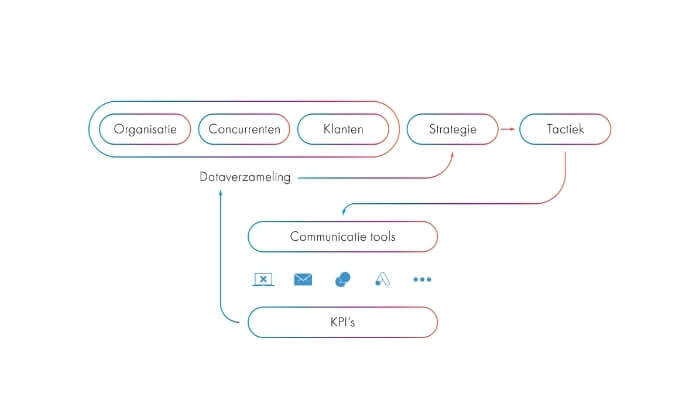
It all starts with collecting the right data, knowing exactly where you stand with your own marketing, what your competitors are doing, and who your customers are. Once you’ve mastered that, you can continue to map out your own targeted marketing path. Based on the gathered knowledge you can build a strong marketing strategy, which you then translate into the right tactical tools.
If you have a good strategy, you can shift your tactics in difficult times instead of throwing everything overboard.
At STRAREX we firmly believe that organizations with a thorough marketing strategy have the right basis and therefore are better equipped to cope with drastic changes in both customer and market demand and behavior, and able to respond quickly and effectively.
The big difference we saw is that these companies were able to adapt on a tactical level and not only react but adapt to the change. By effectively understanding your organization, competitors, and customers, you can quickly detect and adapt. These companies are agile, and that’s a huge advantage in an ever changing market.
If you want to be able to adapt quickly, there’s one statement that is incredibly important:
“To measure is to know, to guess is to miss and to gamble is to lose”.
(note: this is a very liberal and imperfect translation of a Belgian proverb)
The world has changed and so should you!
What’s next? We don’t know either. We hope everything will return to normal soon, and that we can all go back to our festivals, drink rosé with our friends on the beach, see all family whenever we want, and be done with the awkward 1.5 meter distancing. However, there’s little chance that that will be possible again in the near future. We’ll likely go on for a while in this economic and social setting.
One thing is for sure: consumer behavior has changed and so should your approach to marketing. Don’t expect things to return to “the way they used to be” and accept the new normal. Stop one-shot tactical campaigns, build a strong foundation, understand your business, get to know your market and adapt to the needs of your customers in the new world. Be ready to be flexible and adapt to an ever-changing economic landscape.
Contact us and together, we’ll build a robust marketing strategy tailored to your business.
